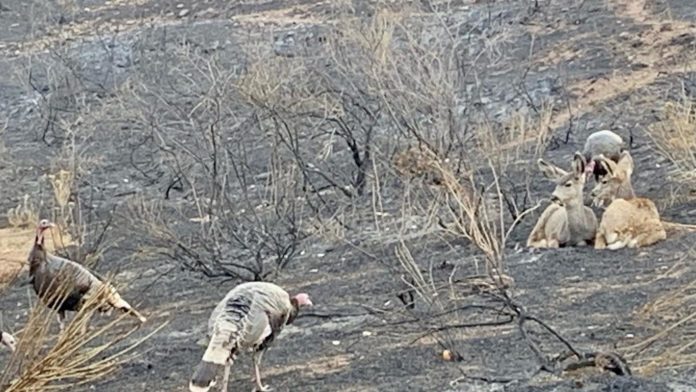A Loveland man was trapped by the roaring fire in the Roosevelt National Forest until a helicopter whisked him away to safety.
Fort Collins Coloradoan
Colton McDonald saw up close just how wildlife reacts to a wildfire.
The Loveland resident was on a 10-day backpacking and fly fishing trip in the Rawah Wilderness of the Roosevelt National Forest when on his first day — Aug. 13 — he saw the start of the Cameron Peak Fire, which Friday marked its 100th day.
McDonald is the only person who had to be rescued from what became the largest wildfire in state history at nearly 209,000 acres. It is 92% contained.
As the fire grew, smoke forced McDonald out of the valleys and to the edge of treeline. He said it was there he began to encounter “more wildlife than I’ve ever seen.”
“After the first couple of days, I noticed an odd amount of deer, moose, bighorn sheep and lot of birds kind of following me,” he said in a previous interview. “And so I kind of knew I was in the right area because all of the wildlife was fleeing to where I was, and wildlife knows where to go when there is a fire.”
Cameron Peak Fire: Memories and misery
Angelique Curtis, a Colorado Parks and Wildlife wildlife biologist for the northeast region, said wildlife has adapted to fire and it should come as no surprise that when fire occurs, wildlife flees.
Last year, she placed radio collars on 30 cow elk where the Cameron Peak Fire has now burned for a study to look at migration and population. She tracked the animals’ movement over a fire progression map and found the elk not only didn’t die in the fire, but found life within the fire.
“We had elk on the perimeter of the fire and it never really moved them off their locations,” Curtis said via a CPW video. “It didn’t make them run 50 miles in one direction or another. They stayed there even though there was active fire, and as the fire progressed, elk actually moved to the active fire perimeter.
“My thought is that there were islands of unburned habitat within the perimeter that the elk were going to use.”
Curtis said after the fire burned through the area in mid-September, snow fell, vegetation started to green soon thereafter and the elk moved in. She said the behavior is similar to what biologists call the “green wave,” in which elk migrate in spring led by where vegetation is greening up.
“It showcases animals are very well adapted and they know when there is danger and when there is not,” she said. “The nutrition afforded in those area was more valued than other areas so they stayed.”
She said the fire burned the elk’s summer range and it is unknown what impact the fire will have long-term on the herd.
CPW wildlife biologists know some animals died in the fire. The area is home to wildlife such as moose, elk, deer, bighorn sheep, black bears, mountain lions, coyotes, wild turkeys and smaller animals like rabbits and squirrels. They suspect smaller animals likely didn’t fare as well as larger animals, which could flee more easily.
Shannon Schaller, senior wildlife biologist for CPW’s northeast region, said in a recent CPW podcast that it is too soon to determine the loss of wildlife due to the wildfire. More than 650,000 acres burned in Colorado this year, the most on record.
She said it’s likely the East Troublesome Fire had more potential to kill wildlife than the Cameron Peak Fire because of the speed at which it burned. On Oct. 21, the East Troublesome Fire burned more than 100,000 acres and ran more than 18 miles in a 24-hour period from Grand Lake through Rocky Mountain National Park to the edge of Estes Park.
The Cameron Peak Fire’s largest single-day run was 41,739 acres Sept. 7.
“They can get out of the way, depending on the speed of the fire,” Schaller said. “The East Troublesome spread very rapidly, and unfortunately there will be some wildlife that did not get out of the way. The good thing is because of the time of the year, we did not have wildlife babies on the ground.”
The fires also impacted Colorado’s popular big game hunting seasons. The deer and elk hunting seasons account for more than $900 million in economic impact statewide.
Jason Clay, CPW spokesman for the northeast region, said part of the fire’s impacts on deer and elk will become known when the agency conducts its annual winter flight surveys.
He said wildlife officers have received more bear reports in the lower portion of the Poudre Canyon than they normally do, which could be because of fire activity.
One Poudre Canyon resident told the Coloradoan a bear ransacked his home near Rustic, which is the eastern edge of the fire, while he was evacuated.
Jeff Spohn, senior aquatic biologist for CPW’s northeast region, said there will be impacts to the Poudre River’s fish population but the extent of the damage won’t be known until the spring runoff brings ash, sediment and debris into the river.
“The Cameron Peak Fire may allow us to reclaim the fishery for native greenback cutthroat trout,” he said via the podcast. “That would be a significant benefit of the fire.”
Grinch of a fire: Cameron Peak Fire steals Christmas tree cutting experience
Reporter Miles Blumhardt looks for stories that impact your life. Be it news, outdoors, sports — you name it, he wants to report it. Have a story idea? Contact him at milesblumhardt@coloradoan.com or on Twitter @MilesBlumhardt. Support his work and that of other Coloradoan journalists by purchasing a digital subscription today.
Read or Share this story: https://www.coloradoan.com/story/news/2020/11/20/cameron-peak-fires-impact-wildlife-might-surprise-you/6309065002/
Credit: Source link































